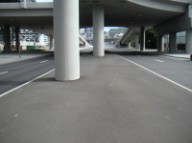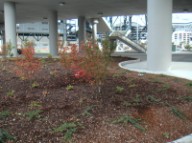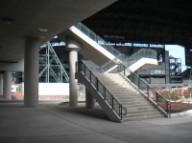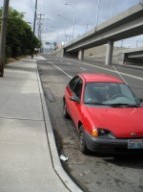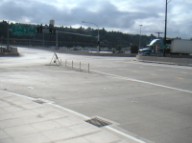It seems that mega-projects are destined to fail on a small scale.
This is part of the special feature Freeway Box, showcasing my old life next to freeway viaducts.
In SR-519 meetings, I dutifully listened and commented as a pedestrian advocate. I read through plans word for word, taxed my brain to visualize maps and renderings.
So why did I not notice, or maybe not care, that the east side of 4th South would be so barren and poorly connected?
I think I got trapped with the designers, engineers, and landscape architects in a Catch 22. 4th Avenue South was never an attractive place to walk. Crossing in the long stretch between Royal Brougham and Holgate, though legal, was never safe at unsignalized intersections. Any improvement seemed welcome, and I was focused on making sure they'd included the major pedestrian movements.
However, going from "bad" to "better" is only measurably positive if the changes are limited in scope. They fundamentally altered the environment by dropping in four freeway-grade ramps, a median for supports, and a stairwell to allow peds to get up and over the train tracks.
The staircase's landing area, on the west side of 4th and adjacent to Safeco Field, is tastefully decorated with low-maintenance shrubs in beds of bark. The underside of ramps on the east side, in contrast, are packed with hardpan gravel.
Standing at the still inhospitable east side, looking west at the staircase that you want to climb to get to the stadium, lured by attractive landscaping, who wouldn't jaywalk to the safe-looking median?
Disembarking from a bus an the west side, Metro drivers choose between jaywalking via the median to the Metro base pedestrian entrance, or taking a 10 to 15 minute detour to Royal Brougham and back. Only someone on a calorie burning regimen would go out of their way to cross legally.
Of course, engineering won't be taken into consideration by police officers writing tickets, or insurance companies determining fault in accidents. WSDOT did due diligence. It just wasn't enough to result in perfect design.
Mega-projects always get some things right and some things wrong. It seems like there's always at least one location that works, and one angle that is photogenic and worthy of the cover of a planning or engineering journal.
Projects like this make me very doubtful that we can pull off the many mega-projects looming in Seattle's future. There are going to be so many important details overlooked in and around light rail and monorail stations, along the Alaska Way Viaduct corridor, and so on.
Perhaps a two-phased approach to pedestrian design is warranted. During regular design and construction, make sure that the infrastructure is built correctly for peds and bikes. After a given percentage of construction is complete, get out and walk and bike the facility. Set aside funds so that adjustments and additions can be made.
Right now the gravel on the east side of 4th looks like a parking strip. Crossings are obscured by freeway supports, but I'm sure there are dozens of jaywalkers after every game. It could use a pedestrian half-signal. I doubt these minor problems, which send strong signals about auto dominance, will ever be fixed. There's only so much we can expect from people, no matter how professional or well-meaning they are.
The real parking strip on the east side is pretty confusing too. Who is this meant to serve? I assume this car belongs to a Metro employee, with the base entrance about 5 meters away. But they have their own parking, the city doesn't need to gift them 4 or 5 unmetered spots. Putting free parking spots right next to the stadiums flies in the face of our attempts to encourage transit usage for event goers. Look in the far distance. You can't even see the nearest building it's so far away. The nearest business is at least 200 meters away, maybe 300. I guarantee that anyone who parks here is going to the Metro base, or jaywalks across to Safeco Field.
The big "positive" in the Atlantic crossing is that the intersection up on top is horrible for cars. All of my driving friends complain about it. It's positive because it's reassuring that small-scale auto problems remain, and not only pedestrian issues are overlooked.
Of course, one letter to "Bumper to Bumper" will probably result in re-engineering of that intersection. Car power!

